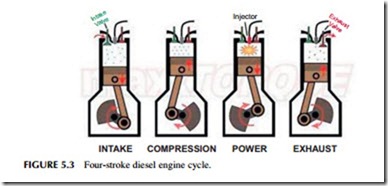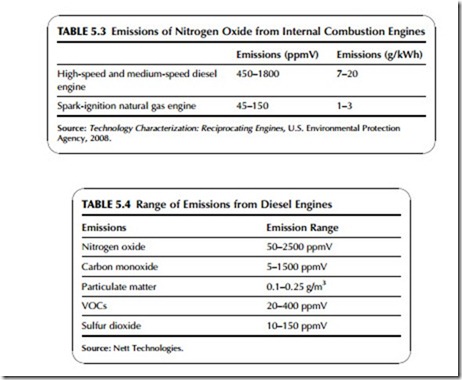DIESEL ENGINES (COMPRESSION ENGINES)
Whereas a spark-ignition engine draws a fuel–air mixture into the cylinder during the first stroke of the four-stroke cycle, in a diesel engine only air is admitted at this stage (Figure 5.3). This air is then compressed much more highly during the succeeding compression stroke than would be the case with a spark-ignition engine, with compression ratios of up to 25:1 typical. When air is compressed adiabatically in this way (just like the air being compressed in a bicycle pump), the compression generates heat so that the air becomes much hotter. In the diesel engine the compression ratio is chosen so that the air temperature rises so high that it is above the ignition temperature of the fuel, in this case diesel. Fuel is admitted into the chamber under pressure toward the top of the compression stroke, when it then ignites spontaneously.
The temperature inside the cylinder of a diesel engine during ignition rises much higher than the temperature in a spark-ignition engine. As a consequence the production of nitrogen oxide is much higher. Typical levels are 450 ppmV to 1800 ppmV, or 10 times higher than for the equivalent spark-ignition engine (see Table 5.3 later, but note that as shown in Table 5.4 that they can rise even higher). Diesel engines, therefore, require extensive emission control systems if they are to comply with air-quality regulations, particularly when the units are operating in an urban environment. Against this, diesel engines are capable of burning biodiesel, a carbon dioxide–emission neutral fuel. This can be attractive in some situations.
The efficiency of the diesel engine ranges from 30% (HHV) for small engines to 48% (HHV) for the largest engines. The highest efficiency yet achieved is 52% for a 67 MW marine diesel engine. Higher temperatures could conceivably produce higher efficiency, but as with other types of
thermodynamic engines, materials will be the limiting factor. Diesel engines can be built to larger sizes than spark-ignition engines, with high-speed machines available in sizes up to 4 MW and slow-speed diesels up to 65 MW. Large, slow-speed engines can have enormous cylinders. For example, a nine-cylinder, 24 MW engine used in a power station in Macau has cylinders with a diameter of 800 mm.
Diesel engines can burn a range of diesel fuels including both oil-derived fuels and biofuels. Smaller, high-speed engines normally use high-quality distillate but the large, slow-speed engines can burn very low-quality heavy fuel oils, which require a much longer combustion time to burn completely. These fuels tend to be dirty and plants burning them usually require additional emission mitigation measures.

